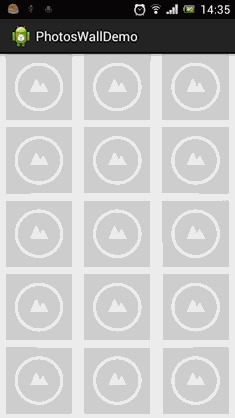转载地址:http://blog.csdn.net/guolin_blog/article/details/9526203
那我们开始动手吧,新建一个Android项目,起名叫LrcPhotoWallDemo,这里我使用的是Android 4.0的API。
第一个要考虑的问题就是,我们从哪儿去收集这么多的图片呢?这里我从谷歌官方提供的Demo里将图片源取了出来,我们就从这些网址中下载图片,代码如下所示:
<span style="font-family:Microsoft YaHei;font-size:18px;">public class Images {
public final static String[] imageUrls = new String[] {
"https://img-my.csdn.net/uploads/201309/01/1378037235_3453.jpg",
"https://img-my.csdn.net/uploads/201309/01/1378037235_7476.jpg",
"https://img-my.csdn.net/uploads/201309/01/1378037235_9280.jpg",
"https://img-my.csdn.net/uploads/201309/01/1378037234_3539.jpg",
"https://img-my.csdn.net/uploads/201309/01/1378037234_6318.jpg",
"https://img-my.csdn.net/uploads/201309/01/1378037194_2965.jpg",
"https://img-my.csdn.net/uploads/201309/01/1378037193_1687.jpg",
"https://img-my.csdn.net/uploads/201309/01/1378037193_1286.jpg",
"https://img-my.csdn.net/uploads/201309/01/1378037192_8379.jpg",
"https://img-my.csdn.net/uploads/201309/01/1378037178_9374.jpg",
"https://img-my.csdn.net/uploads/201309/01/1378037177_1254.jpg",
"https://img-my.csdn.net/uploads/201309/01/1378037177_6203.jpg",
"https://img-my.csdn.net/uploads/201309/01/1378037152_6352.jpg",
"https://img-my.csdn.net/uploads/201309/01/1378037151_9565.jpg",
"https://img-my.csdn.net/uploads/201309/01/1378037151_7904.jpg",
"https://img-my.csdn.net/uploads/201309/01/1378037148_7104.jpg",
"https://img-my.csdn.net/uploads/201309/01/1378037129_8825.jpg",
"https://img-my.csdn.net/uploads/201309/01/1378037128_5291.jpg",
"https://img-my.csdn.net/uploads/201309/01/1378037128_3531.jpg",
"https://img-my.csdn.net/uploads/201309/01/1378037127_1085.jpg",
"https://img-my.csdn.net/uploads/201309/01/1378037095_7515.jpg",
"https://img-my.csdn.net/uploads/201309/01/1378037094_8001.jpg",
"https://img-my.csdn.net/uploads/201309/01/1378037093_7168.jpg",
"https://img-my.csdn.net/uploads/201309/01/1378037091_4950.jpg",
"https://img-my.csdn.net/uploads/201308/31/1377949643_6410.jpg",
"https://img-my.csdn.net/uploads/201308/31/1377949642_6939.jpg",
"https://img-my.csdn.net/uploads/201308/31/1377949630_4505.jpg",
"https://img-my.csdn.net/uploads/201308/31/1377949630_4593.jpg",
"https://img-my.csdn.net/uploads/201308/31/1377949629_7309.jpg",
"https://img-my.csdn.net/uploads/201308/31/1377949629_8247.jpg",
"https://img-my.csdn.net/uploads/201308/31/1377949615_1986.jpg",
"https://img-my.csdn.net/uploads/201308/31/1377949614_8482.jpg",
"https://img-my.csdn.net/uploads/201308/31/1377949614_3743.jpg",
"https://img-my.csdn.net/uploads/201308/31/1377949614_4199.jpg",
"https://img-my.csdn.net/uploads/201308/31/1377949599_3416.jpg",
"https://img-my.csdn.net/uploads/201308/31/1377949599_5269.jpg",
"https://img-my.csdn.net/uploads/201308/31/1377949598_7858.jpg",
"https://img-my.csdn.net/uploads/201308/31/1377949598_9982.jpg",
"https://img-my.csdn.net/uploads/201308/31/1377949578_2770.jpg",
"https://img-my.csdn.net/uploads/201308/31/1377949578_8744.jpg",
"https://img-my.csdn.net/uploads/201308/31/1377949577_5210.jpg",
"https://img-my.csdn.net/uploads/201308/31/1377949577_1998.jpg",
"https://img-my.csdn.net/uploads/201308/31/1377949482_8813.jpg",
"https://img-my.csdn.net/uploads/201308/31/1377949481_6577.jpg",
"https://img-my.csdn.net/uploads/201308/31/1377949480_4490.jpg",
"https://img-my.csdn.net/uploads/201308/31/1377949455_6792.jpg",
"https://img-my.csdn.net/uploads/201308/31/1377949455_6345.jpg",
"https://img-my.csdn.net/uploads/201308/31/1377949442_4553.jpg",
"https://img-my.csdn.net/uploads/201308/31/1377949441_8987.jpg",
"https://img-my.csdn.net/uploads/201308/31/1377949441_5454.jpg",
"https://img-my.csdn.net/uploads/201308/31/1377949454_6367.jpg",
"https://img-my.csdn.net/uploads/201308/31/1377949442_4562.jpg", };
}
</span>- <LinearLayout xmlns:android="http://schemas.android.com/apk/res/android"
- xmlns:tools="http://schemas.android.com/tools"
- android:layout_width="wrap_content"
- android:layout_height="wrap_content" >
- <GridView
- android:id="@+id/photo_wall"
- android:layout_width="match_parent"
- android:layout_height="wrap_content"
- android:columnWidth="90dip"
- android:stretchMode="columnWidth"
- android:numColumns="auto_fit"
- android:verticalSpacing="10dip"
- android:gravity="center"
- ></GridView>
- </LinearLayout>
可以看到,我们在这个布局文件中仅加入了一个GridView,这也就是我们程序中的“墙”,所有的图片都将贴在这个“墙”上。
接着我们定义GridView中每一个子View的布局,新建一个photo_layout.xml布局,加入如下代码:
- <RelativeLayout xmlns:android="http://schemas.android.com/apk/res/android"
- xmlns:tools="http://schemas.android.com/tools"
- android:layout_width="wrap_content"
- android:layout_height="wrap_content" >
- <ImageView
- android:id="@+id/photo"
- android:layout_width="90dip"
- android:layout_height="90dip"
- android:src="@drawable/empty_photo"
- android:layout_centerInParent="true"
- />
- </RelativeLayout>
接下来新建PhotoWallAdapter做为GridView的适配器,代码如下所示:
<span style="font-family:Microsoft YaHei;font-size:18px;">public class PhotoWallAdapter extends ArrayAdapter<String> implements OnScrollListener {
/**
* 记录所有正在下载或等待下载的任务。
*/
private Set<BitmapWorkerTask> taskCollection;
/**
* 图片缓存技术的核心类,用于缓存所有下载好的图片,在程序内存达到设定值时会将最少最近使用的图片移除掉。
*/
private LruCache<String, Bitmap> mMemoryCache;
/**
* GridView的实例
*/
private GridView mPhotoWall;
/**
* 第一张可见图片的下标
*/
private int mFirstVisibleItem;
/**
* 一屏有多少张图片可见
*/
private int mVisibleItemCount;
/**
* 记录是否刚打开程序,用于解决进入程序不滚动屏幕,不会下载图片的问题。
*/
private boolean isFirstEnter = true;
@SuppressLint("NewApi") public PhotoWallAdapter(Context context, int textViewResourceId, String[] objects,
GridView photoWall) {
super(context, textViewResourceId, objects);
mPhotoWall = photoWall;
taskCollection = new HashSet<BitmapWorkerTask>();
// 获取应用程序最大可用内存
int maxMemory = (int) Runtime.getRuntime().maxMemory();
int cacheSize = maxMemory / 8;
// 设置图片缓存大小为程序最大可用内存的1/8
mMemoryCache = new LruCache<String, Bitmap>(cacheSize) {
@Override
protected int sizeOf(String key, Bitmap bitmap) {
return bitmap.getByteCount();
}
};
mPhotoWall.setOnScrollListener(this);
}
@Override
public View getView(int position, View convertView, ViewGroup parent) {
final String url = getItem(position);
View view;
if (convertView == null) {
view = LayoutInflater.from(getContext()).inflate(R.layout.photo_layout, null);
} else {
view = convertView;
}
final ImageView photo = (ImageView) view.findViewById(R.id.photo);
// 给ImageView设置一个Tag,保证异步加载图片时不会乱序
photo.setTag(url);
setImageView(url, photo);
return view;
}
/**
* 给ImageView设置图片。首先从LruCache中取出图片的缓存,设置到ImageView上。如果LruCache中没有该图片的缓存,
* 就给ImageView设置一张默认图片。
*
* @param imageUrl
* 图片的URL地址,用于作为LruCache的键。
* @param imageView
* 用于显示图片的控件。
*/
private void setImageView(String imageUrl, ImageView imageView) {
Bitmap bitmap = getBitmapFromMemoryCache(imageUrl);
if (bitmap != null) {
imageView.setImageBitmap(bitmap);
} else {
imageView.setImageResource(R.drawable.empty_photo);
}
}
/**
* 将一张图片存储到LruCache中。
*
* @param key
* LruCache的键,这里传入图片的URL地址。
* @param bitmap
* LruCache的键,这里传入从网络上下载的Bitmap对象。
*/
public void addBitmapToMemoryCache(String key, Bitmap bitmap) {
if (getBitmapFromMemoryCache(key) == null) {
mMemoryCache.put(key, bitmap);
}
}
/**
* 从LruCache中获取一张图片,如果不存在就返回null。
*
* @param key
* LruCache的键,这里传入图片的URL地址。
* @return 对应传入键的Bitmap对象,或者null。
*/
@SuppressLint("NewApi") public Bitmap getBitmapFromMemoryCache(String key) {
return mMemoryCache.get(key);
}
@Override
public void onScrollStateChanged(AbsListView view, int scrollState) {
// 仅当GridView静止时才去下载图片,GridView滑动时取消所有正在下载的任务
if (scrollState == SCROLL_STATE_IDLE) {
loadBitmaps(mFirstVisibleItem, mVisibleItemCount);
} else {
cancelAllTasks();
}
}
@Override
public void onScroll(AbsListView view, int firstVisibleItem, int visibleItemCount,
int totalItemCount) {
mFirstVisibleItem = firstVisibleItem;
mVisibleItemCount = visibleItemCount;
// 下载的任务应该由onScrollStateChanged里调用,但首次进入程序时onScrollStateChanged并不会调用,
// 因此在这里为首次进入程序开启下载任务。
if (isFirstEnter && visibleItemCount > 0) {
loadBitmaps(firstVisibleItem, visibleItemCount);
isFirstEnter = false;
}
}
/**
* 加载Bitmap对象。此方法会在LruCache中检查所有屏幕中可见的ImageView的Bitmap对象,
* 如果发现任何一个ImageView的Bitmap对象不在缓存中,就会开启异步线程去下载图片。
*
* @param firstVisibleItem
* 第一个可见的ImageView的下标
* @param visibleItemCount
* 屏幕中总共可见的元素数
*/
private void loadBitmaps(int firstVisibleItem, int visibleItemCount) {
try {
for (int i = firstVisibleItem; i < firstVisibleItem + visibleItemCount; i++) {
String imageUrl = Images.imageUrls[i];
Bitmap bitmap = getBitmapFromMemoryCache(imageUrl);
if (bitmap == null) {
BitmapWorkerTask task = new BitmapWorkerTask();
taskCollection.add(task);
task.execute(imageUrl);
} else {
ImageView imageView = (ImageView) mPhotoWall.findViewWithTag(imageUrl);
if (imageView != null && bitmap != null) {
imageView.setImageBitmap(bitmap);
}
}
}
} catch (Exception e) {
e.printStackTrace();
}
}
/**
* 取消所有正在下载或等待下载的任务。
*/
public void cancelAllTasks() {
if (taskCollection != null) {
for (BitmapWorkerTask task : taskCollection) {
task.cancel(false);
}
}
}
/**
* 异步下载图片的任务。
*
* @author guolin
*/
class BitmapWorkerTask extends AsyncTask<String, Void, Bitmap> {
/**
* 图片的URL地址
*/
private String imageUrl;
@Override
protected Bitmap doInBackground(String... params) {
imageUrl = params[0];
// 在后台开始下载图片
Bitmap bitmap = downloadBitmap(params[0]);
if (bitmap != null) {
// 图片下载完成后缓存到LrcCache中
addBitmapToMemoryCache(params[0], bitmap);
}
return bitmap;
}
@Override
protected void onPostExecute(Bitmap bitmap) {
super.onPostExecute(bitmap);
// 根据Tag找到相应的ImageView控件,将下载好的图片显示出来。
ImageView imageView = (ImageView) mPhotoWall.findViewWithTag(imageUrl);
if (imageView != null && bitmap != null) {
imageView.setImageBitmap(bitmap);
}
taskCollection.remove(this);
}
/**
* 建立HTTP请求,并获取Bitmap对象。
*
* @param imageUrl
* 图片的URL地址
* @return 解析后的Bitmap对象
*/
private Bitmap downloadBitmap(String imageUrl) {
Bitmap bitmap = null;
HttpURLConnection con = null;
try {
URL url = new URL(imageUrl);
con = (HttpURLConnection) url.openConnection();
con.setConnectTimeout(5 * 1000);
con.setReadTimeout(10 * 1000);
bitmap = BitmapFactory.decodeStream(con.getInputStream());
} catch (Exception e) {
e.printStackTrace();
} finally {
if (con != null) {
con.disconnect();
}
}
return bitmap;
}
}
} </span>看了半天,那到底是在哪里下载图片的呢?这是在GridView的滚动监听器中进行的,在onScrollStateChanged()方法中,我们对GridView的滚动状态进行了判断,如果当前GridView是静止的,则调用loadBitmaps()方法去下载图片,如果GridView正在滚动,则取消掉所有下载任务,这样可以保证GridView滚动的流畅性。在loadBitmaps()方法中,我们为屏幕上所有可见的GridView子元素开启了一个线程去执行下载任务,下载成功后将图片存储到LruCache当中,然后通过Tag找到相应的ImageView控件,把下载好的图片显示出来。
由于我们使用了LruCache来缓存图片,所以不需要担心内存溢出的情况,当LruCache中存储图片的总大小达到容量上限的时候,会自动把最近最少使用的图片从缓存中移除。
最后新建或打开MainActivity作为程序的主Activity,代码如下所示:
<span style="font-family:Microsoft YaHei;font-size:18px;">public class MainActivity extends Activity {
/**
* 用于展示照片墙的GridView
*/
private GridView mPhotoWall;
/**
* GridView的适配器
*/
private PhotoWallAdapter adapter;
@Override
protected void onCreate(Bundle savedInstanceState) {
super.onCreate(savedInstanceState);
setContentView(R.layout.activity_main);
mPhotoWall = (GridView) findViewById(R.id.photo_wall);
adapter = new PhotoWallAdapter(this, 0, Images.imageUrls, mPhotoWall);
mPhotoWall.setAdapter(adapter);
}
@Override
protected void onDestroy() {
super.onDestroy();
// 退出程序时结束所有的下载任务
adapter.cancelAllTasks();
}
} </span>MainActivity中的代码非常简单,没什么需要说明的了,在Activity被销毁时取消掉了所有的下载任务,避免程序在后台耗费流量。另外由于我们使用了网络功能,别忘了在AndroidManifest.xml中加入网络权限的声明。
现在可以运行一下程序了,效果如下图所示:
可以看到,滚动照片墙,会异步加载图片到相应的ImageView上。随着加载图片的增多,会释放掉一些之前加载过的图片,你多滚动几次就可以看得出了。另外为了能让大家明显看出图片的释放情况,我在这个程序中没有使用本地缓存,所有被释放掉的图片再次显示需要从网络上再下载一遍。在实际的项目中配合适当的本地缓存效果会更好。
打开DDMS,我们可以发现,由于有LruCache帮我们管理图片缓存,不管如何滚动照片墙,程序内存始终会保持在一个合理的范围内。
本篇文章的重点在于如何对图片进行更好的回收,因此照片墙只是简单地使用GridView进行了展示

























 被折叠的 条评论
为什么被折叠?
被折叠的 条评论
为什么被折叠?








